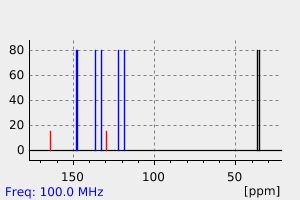(E)-N,N-dimethyl-3-(3-pyridinyl)prop-2-enamide | 59093-01-5
中文名称
——
中文别名
——
英文名称
(E)-N,N-dimethyl-3-(3-pyridinyl)prop-2-enamide
英文别名
(E)-N,N-dimethyl 3-(pyridin-3-yl)acrylamide;(E)-N,N-dimethyl-3-(pyridin-3-yl)acrylamide;N,N-Dimethyl-3-pyridinacrylamid;(2E)-N,N-dimethyl-3-pyridin-3-ylacrylamide;(E)-N,N-dimethyl-3-pyridin-3-ylprop-2-enamide
CAS
59093-01-5
化学式
C10H12N2O
mdl
——
分子量
176.218
InChiKey
FSNGYQKSFARNFS-AATRIKPKSA-N
BEILSTEIN
——
EINECS
——
-
物化性质
-
计算性质
-
ADMET
-
安全信息
-
SDS
-
制备方法与用途
-
上下游信息
-
文献信息
-
表征谱图
-
同类化合物
-
相关功能分类
-
相关结构分类
物化性质
-
沸点:354.8±25.0 °C(Predicted)
-
密度:1.094±0.06 g/cm3(Predicted)
计算性质
-
辛醇/水分配系数(LogP):0.7
-
重原子数:13
-
可旋转键数:2
-
环数:1.0
-
sp3杂化的碳原子比例:0.2
-
拓扑面积:33.2
-
氢给体数:0
-
氢受体数:2
上下游信息
-
上游原料
中文名称 英文名称 CAS号 化学式 分子量 —— (E)-3-(3-pyridyl)acrylic acid chloride 1126-72-3 C8H6ClNO 167.595 反-3(3-吡啶基)烯丙酸 trans-3-(3-pyridyl)acrylic acid 19337-97-4 C8H7NO2 149.149 3-(3-吡啶)丙烯酸 3-(pyridin-3-yl)acrylic acid 1126-74-5 C8H7NO2 149.149
反应信息
-
作为反应物:描述:乙基溴化镁 、 (E)-N,N-dimethyl-3-(3-pyridinyl)prop-2-enamide 在 三氟甲磺酸三甲基硅酯 作用下, 以 二氯甲烷 为溶剂, 反应 2.0h, 生成 N,N-dimethyl-3-(3-pyridinyl)pentanamide参考文献:名称:路易斯酸使铜催化不对称合成手性 β-取代酰胺摘要:在这里,我们报告说,容易获得的基于甲硅烷基和硼的路易斯酸与手性铜催化剂结合能够克服未活化的烯酰胺(被称为反应性最低的羧酸衍生物)对有机镁试剂进行烷基化的反应性问题。在催化不对称共轭加成到烯酰胺中允许无与伦比的化学反应性和立体控制,该方法以其前所未有的反应范围而著称,即使是最具挑战性和合成上重要的甲基化也能以良好的产率和出色的对映选择性完成。该催化协议可耐受较宽的温度范围(-78 °C 至环境温度)和放大(10 g),而手性催化剂可以重复使用而不会影响整体效率。DOI:10.1021/jacs.7b07344
-
作为产物:描述:反-3(3-吡啶基)烯丙酸 在 氯化亚砜 、 三乙胺 作用下, 以 二氯甲烷 、 N,N-二甲基甲酰胺 为溶剂, 反应 5.0h, 生成 (E)-N,N-dimethyl-3-(3-pyridinyl)prop-2-enamide参考文献:名称:路易斯酸使铜催化不对称合成手性 β-取代酰胺摘要:在这里,我们报告说,容易获得的基于甲硅烷基和硼的路易斯酸与手性铜催化剂结合能够克服未活化的烯酰胺(被称为反应性最低的羧酸衍生物)对有机镁试剂进行烷基化的反应性问题。在催化不对称共轭加成到烯酰胺中允许无与伦比的化学反应性和立体控制,该方法以其前所未有的反应范围而著称,即使是最具挑战性和合成上重要的甲基化也能以良好的产率和出色的对映选择性完成。该催化协议可耐受较宽的温度范围(-78 °C 至环境温度)和放大(10 g),而手性催化剂可以重复使用而不会影响整体效率。DOI:10.1021/jacs.7b07344
文献信息
-
Copper catalyzed cross-coupling reactions of carboxylic acids: an expedient route to amides, 5-substituted γ-lactams and α-acyloxy esters作者:S. Priyadarshini、P. J. Amal Joseph、M. Lakshmi KantamDOI:10.1039/c3ra41000e日期:——A convenient and recyclable catalytic protocol for the synthesis of N,N-dimethyl substituted amides, 5-substituted γ-lactams and α-acyloxy ethers from carboxylic acids using CuO nanoparticles and TBHP is described.
-
HETEROCYCLIC COMPOUNDS AND USES THEREOF申请人:SINGH Juswinder公开号:US20080300268A1公开(公告)日:2008-12-04The present invention provides compounds, pharmaceutically acceptable compositions thereof, and methods of using the same.本发明提供了化合物、药学上可接受的组合物以及使用它们的方法。
-
Role of Mono-N-protected Amino Acid Ligands in Palladium(II)-Catalyzed Dehydrogenative Heck Reactions of Electron-Deficient (Hetero)arenes: Experimental and Computational Studies作者:Xuefeng Cong、Huarong Tang、Chao Wu、Xiaoming ZengDOI:10.1021/om400890p日期:2013.11.11We report here that mono-N-protected amino acids (MPAAs), an important environmentally compatible structural motif, enable acceleration of Pd(II)-catalyzed dehydrogenative Heck reactions between pyridines and electron-deficient arenes with simple alkenes, leading to diversely functionalized C3- or meta-selective alkenylated pyridines and benzenes via non-chelate-assisted C–H activation. A comprehensive我们在这里报告,单N保护的氨基酸(MPAAs),一种重要的环境相容性结构基序,能够加速Pd(II)催化的吡啶和电子不足的芳烃与简单烯烃之间的脱氢Heck反应,从而导致功能化的C3 -或meta通过非螯合物辅助的C–H活化选择性烯基化吡啶和苯。通过DFT计算进行的全面理论研究表明,MPAA配体的氨基支架通过最初的N–H活化容易地转化为X型配体,从而导致吡啶C–H裂解的活化障碍相对较低。然后,氨基的性质从X型配体转变为L型配体使得烯烃取代可以顺利进行,而羧基则可以形成分子内氢键,从而大大降低了碳pal触动的激活障碍。计算结果和动力学同位素效应测量结果支持了限速C–H活化,其机制涉及协同的金属化/去质子化途径,吸热值为31。
-
MODULATORS FOR AMYLOID BETA申请人:Baumann Karlheinz公开号:US20090215759A1公开(公告)日:2009-08-27The invention relates to compounds of formula wherein the substituents are as described in claim 1 . Compounds of formula I are modulators for amyloid beta and thus, they may be useful for the treatment or prevention of a disease associated with the deposition of β-amyloid in the brain, in particular Alzheimer's disease, and other diseases such as cerebral amyloid angiopathy, hereditary cerebral hemorrhage with amyloidosis, Dutch-type (HCHWA-D), multi-infarct dementia, dementia pugilistica and Down syndrome.该发明涉及以下式的化合物 其中取代基如权利要求中所述 。式I的化合物是淀粉样蛋白β的调节剂,因此它们可能对治疗或预防与大脑中β-淀粉样蛋白沉积相关的疾病有用,特别是阿尔茨海默病,以及其他疾病,如脑淀粉样血管病变,遗传性脑出血伴淀粉样变性,荷兰型(HCHWA-D),多梗死性痴呆,拳击性痴呆和唐氏综合征。
-
ALGORITHM FOR DESIGNING IRREVERSIBLE INHIBITORS申请人:Singh Juswinder公开号:US20100185419A1公开(公告)日:2010-07-22The invention is an algorithm and method for designing an inhibitor that covalently binds a target polypeptide. The algorithm and method can be used to rapidly and efficiently convert reversible inhibitors into irreversible inhibitors.
表征谱图
-
氢谱1HNMR
-
质谱MS
-
碳谱13CNMR
-
红外IR
-
拉曼Raman
-
峰位数据
-
峰位匹配
-
表征信息
同类化合物
(S)-氨氯地平-d4
(R,S)-可替宁N-氧化物-甲基-d3
(R)-(+)-2,2'',6,6''-四甲氧基-4,4''-双(二苯基膦基)-3,3''-联吡啶(1,5-环辛二烯)铑(I)四氟硼酸盐
(R)-N'-亚硝基尼古丁
(R)-DRF053二盐酸盐
(5E)-5-[(2,5-二甲基-1-吡啶-3-基-吡咯-3-基)亚甲基]-2-亚磺酰基-1,3-噻唑烷-4-酮
(5-溴-3-吡啶基)[4-(1-吡咯烷基)-1-哌啶基]甲酮
(5-氨基-6-氰基-7-甲基[1,2]噻唑并[4,5-b]吡啶-3-甲酰胺)
(2S,2'S)-(-)-[N,N'-双(2-吡啶基甲基]-2,2'-联吡咯烷双(乙腈)铁(II)六氟锑酸盐
(2S)-2-[[[9-丙-2-基-6-[(4-吡啶-2-基苯基)甲基氨基]嘌呤-2-基]氨基]丁-1-醇
(2R,2''R)-(+)-[N,N''-双(2-吡啶基甲基)]-2,2''-联吡咯烷四盐酸盐
(1'R,2'S)-尼古丁1,1'-Di-N-氧化物
黄色素-37
麦斯明-D4
麦司明
麝香吡啶
鲁非罗尼
鲁卡他胺
高氯酸N-甲基甲基吡啶正离子
高氯酸,吡啶
高奎宁酸
马来酸溴苯那敏
马来酸氯苯那敏-D6
马来酸左氨氯地平
顺式-双(异硫氰基)(2,2'-联吡啶基-4,4'-二羧基)(4,4'-二-壬基-2'-联吡啶基)钌(II)
顺式-二氯二(4-氯吡啶)铂
顺式-二(2,2'-联吡啶)二氯铬氯化物
顺式-1-(4-甲氧基苄基)-3-羟基-5-(3-吡啶)-2-吡咯烷酮
顺-双(2,2-二吡啶)二氯化钌(II) 水合物
顺-双(2,2'-二吡啶基)二氯化钌(II)二水合物
顺-二氯二(吡啶)铂(II)
顺-二(2,2'-联吡啶)二氯化钌(II)二水合物
韦德伊斯试剂
非那吡啶
非洛地平杂质C
非洛地平
非戈替尼
非布索坦杂质66
非尼拉朵
非尼拉敏
雷索替丁
阿雷地平
阿瑞洛莫
阿扎那韦中间体
阿培利司N-6
阿伐曲波帕杂质40
间硝苯地平
间-硝苯地平
镉,二碘四(4-甲基吡啶)-
锌,二溴二[4-吡啶羧硫代酸(2-吡啶基亚甲基)酰肼]-







